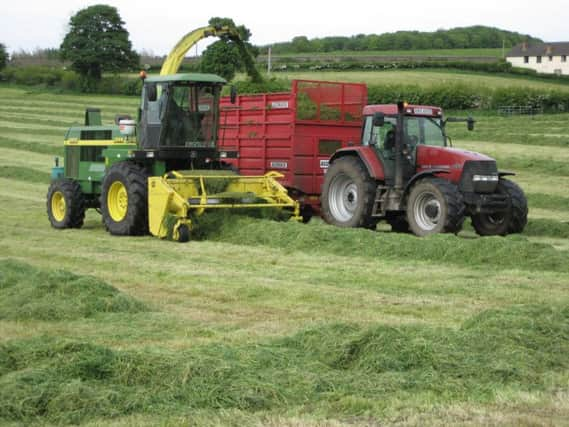Take steps to prepare high quality silage for next winter


AFBI research shows that good silage quality is critical to achieve good animal performance.
l Each unit increase in silage D value increases milk yield by 0.3-0.4 litres/day.
Advertisement
Hide AdAdvertisement
Hide Adl A delay in harvesting of one week from mid May onwards typically results in a reduction in D-value of up to three units.
l Consequently, each one week delay in harvesting after mid May typically results in a reduction in milk yield of 1.0 -1.2 litres/day.
The key message is: Plan now to ensure grass is harvested at the right stage to maximise the potential of your silage next winter.
Grass development and
silage quality
The onset of seed heading in grass in spring is determined by increasing day length – each variety researches a “critical” day length after which it starts to grow reproductively. Grass variety trials at AFBI Crossnacreevy show that the critical day length for most ryegrass varieties occurs in March/April, with temperature having a major effect on grass yield and quality thereafter.
Advertisement
Hide AdAdvertisement
Hide AdAs a rule of thumb, first cut silage grass will be around 67D when 50% of the sward is showing seed heads. So to target high quality grass of 70 -73D and above, means cutting well before any seed heads appear, normally in early to mid May. In a cool season, such as this year, when leaf bulk has not been built early in the season, delaying harvest too long for a good yield only produces more stem of lower quality and reduces yield of second cut. With intermediate and late variety mixtures, heading can spread over two weeks with some varieties naturally holding higher quality levels longer, even through to the end of May.
Silage quality and
livestock performance
Research at AFBI, Hillsborough, has shown that the quality of grass at harvest is the key factor which determines the capacity of cattle and sheep to maximise nutrient intake from silage. Good quality silage is characterised by high digestibility and metabolisable energy contents, which means that more of the nutrients are captured for milk production and growth, with less wasted in manure and gaseous losses. This is particularly important for autumn and winter calving dairy cows where concentrate supplementation can substantially add to production costs.
Results from the Hillsborough Feeding Information System over the last twenty years show a major variation in silage produced on local farms as shown in Table 1, with D values ranging from 52 to 77 (equivalent to ME values of 8.3 to 12.3 MJ/kg DM). The difference between these two extremes is equivalent to 7.2 litres/milk/day, assuming that the same level of concentrates was fed with both silages as shown in Figure 1. While these values are at the extremes of the range found on farms, they demonstrate the major impact of cutting date on silage quality and animal performance.
Understanding silage
quality analysis
The Hillsborough Feeding Information System was established in 1996 using the latest analytical technology to evaluate silage in terms of intake characteristics, energy and protein value and to predict performance of dairy cows, growing cattle, suckler cows, breeding sheep and lambs. Twenty years later the System is still at the forefront of silage analysis internationally.
Advertisement
Hide AdAdvertisement
Hide AdFrom the outset, it was recognised that the quality and composition of grass at the time of ensiling had a major influence on silage fermentation and the feeding value of the resulting silage. The grass ensilability test offered by the Hillsborough Feeding Information System provides a very good indication of how well grass will preserve and whether an additive is required to guarantee good fermentation.
Grass ensilability analysis provides information on dry matter, protein, sugar (water soluble carbohydrate), nitrate – N and buffering capacity values. Nitrate N analysis will be particularly important this year given the cold spring conditions and late application of N fertiliser on most silage ground. If nitrate N is still high at the time of ensiling, then residual fertilizer is still being processed into protein within the grass plant. Levels can be as high as 6000 ppm in very young leafy grass, which if ensiled can lead to very poor fermentation. Buffering Capacity is an indicator of how the grass resists the change in acidity as the soluble sugars ferment into lactic acid to give a stable pH.
Silage swards should be sampled around a week before the expected harvest date to determine whether to go ahead or wait to allow nitrate levels to decrease. However, a balance needs to be struck, as waiting too long will result in a reduction in D value. An effective silage additive should be considered when nitrate levels are higher than normal, as this should assist in ensuring satisfactory silage fermentation.
Conclusions
Grass silage is the most important component of winter feeding. Given the rapid decline in grass quality from mid-late May onwards, harvesting of first cut grass to produce high quality silage should be targeted for completion by the end of May. Grass ensilability testing prior to harvest helps in decision making, particularly in relation to timing of first cut and whether an additive is required.